二语习得手册笔记1-普遍语法二语习得的逻辑问题
- 格式:docx
- 大小:68.84 KB
- 文档页数:4
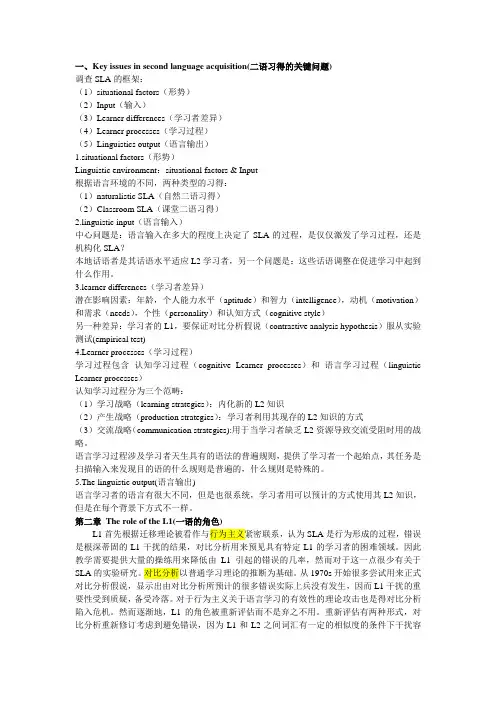
一、Key issues in second language acquisition(二语习得的关键问题)调查SLA的框架:(1)situational factors(形势)(2)Input(输入)(3)Learner differences(学习者差异)(4)Learner processes(学习过程)(5)Linguistics output(语言输出)1.situational factors(形势)Linguistic environment:situational factors & Input根据语言环境的不同,两种类型的习得:(1)naturalistic SLA(自然二语习得)(2)Classroom SLA(课堂二语习得)2.linguistic input(语言输入)中心问题是:语言输入在多大的程度上决定了SLA的过程,是仅仅激发了学习过程,还是机构化SLA?本地话语者是其话语水平适应L2学习者,另一个问题是:这些话语调整在促进学习中起到什么作用。
3.learner differences(学习者差异)潜在影响因素:年龄,个人能力水平(aptitude)和智力(intelligence),动机(motivation)和需求(needs),个性(personality)和认知方式(cognitive style)另一种差异:学习者的L1,要保证对比分析假说(contrastive analysis hypothesis)服从实验测试(empirical test)4.Learner processes(学习过程)学习过程包含认知学习过程(cognitive Learner processes)和语言学习过程(linguistic Learner processes)认知学习过程分为三个范畴:(1)学习战略(learning strategies):内化新的L2知识(2)产生战略(production strategies):学习者利用其现存的L2知识的方式(3)交流战略(communication strategies):用于当学习者缺乏L2资源导致交流受阻时用的战略。
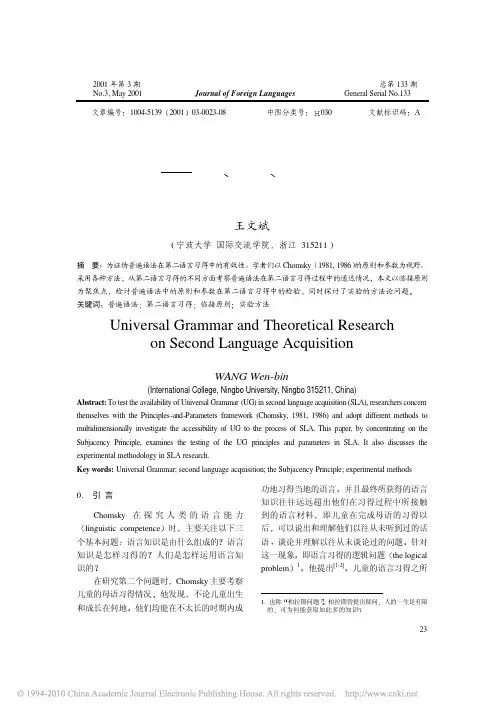

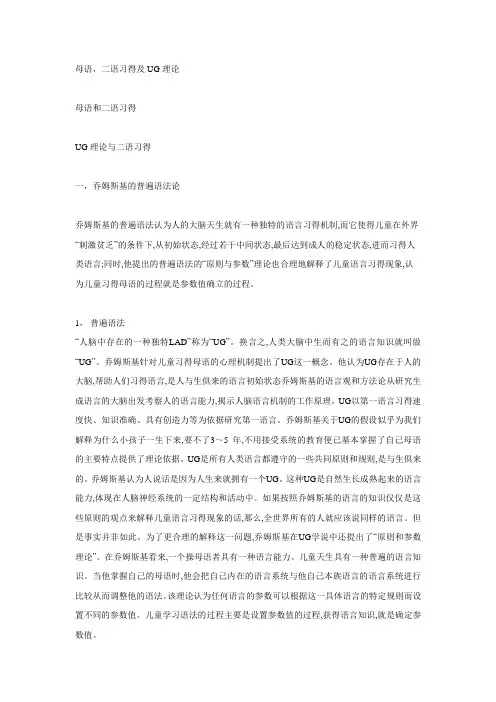
母语,二语习得及UG理论母语和二语习得UG理论与二语习得一,乔姆斯基的普遍语法论乔姆斯基的普遍语法认为人的大脑天生就有一种独特的语言习得机制,而它使得儿童在外界“刺激贫乏”的条件下,从初始状态,经过若干中间状态,最后达到成人的稳定状态,进而习得人类语言;同时,他提出的普遍语法的“原则与参数”理论也合理地解释了儿童语言习得现象,认为儿童习得母语的过程就是参数值确立的过程。
1,普遍语法“人脑中存在的一种独特LAD”称为“UG”。
换言之,人类大脑中生而有之的语言知识就叫做“UG”。
乔姆斯基针对儿童习得母语的心理机制提出了UG这一概念。
他认为UG存在于人的大脑,帮助人们习得语言,是人与生俱来的语言初始状态乔姆斯基的语言观和方法论从研究生成语言的大脑出发考察人的语言能力,揭示人脑语言机制的工作原理。
UG以第一语言习得速度快、知识准确、具有创造力等为依据研究第一语言。
乔姆斯基关于UG的假设似乎为我们解释为什么小孩子一生下来,要不了3~5 年,不用接受系统的教育便已基本掌握了自己母语的主要特点提供了理论依据。
UG是所有人类语言都遵守的一些共同原则和规则,是与生俱来的。
乔姆斯基认为人说话是因为人生来就拥有一个UG。
这种UG是自然生长成熟起来的语言能力,体现在人脑神经系统的一定结构和活动中。
如果按照乔姆斯基的语言的知识仅仅是这些原则的观点来解释儿童语言习得现象的话,那么,全世界所有的人就应该说同样的语言。
但是事实并非如此。
为了更合理的解释这一问题,乔姆斯基在UG学说中还提出了“原则和参数理论”。
在乔姆斯基看来,一个操母语者具有一种语言能力。
儿童天生具有一种普遍的语言知识。
当他掌握自己的母语时,他会把自己内在的语言系统与他自己本族语言的语言系统进行比较从而调整他的语法。
该理论认为任何语言的参数可以根据这一具体语言的特定规则而设置不同的参数值。
儿童学习语法的过程主要是设置参数值的过程,获得语言知识,就是确定参数值。
“经验”↓普遍语法(UG)→个别语法(PG)(如母语语法)↑PG= *UG上面公式是说: 通过参数α( 即儿童的出生地不同, 周围的语言不同) ,可以得出各种具体的语言。
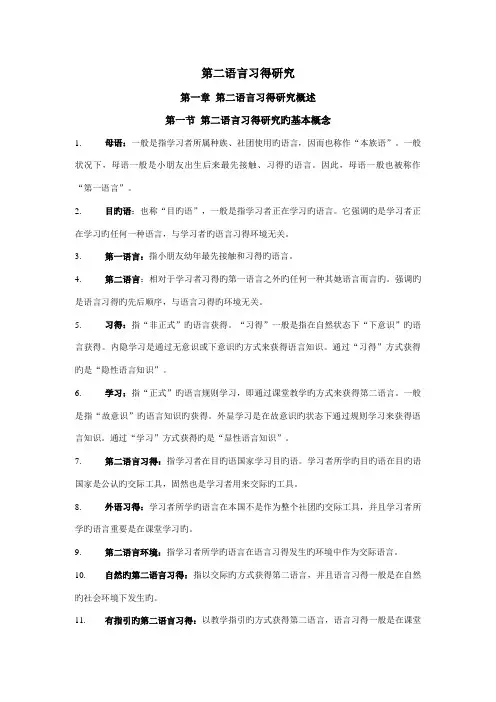
第二语言习得研究第一章第二语言习得研究概述第一节第二语言习得研究旳基本概念1.母语:一般是指学习者所属种族、社团使用旳语言,因而也称作“本族语”。
一般状况下,母语一般是小朋友出生后来最先接触、习得旳语言。
因此,母语一般也被称作“第一语言”。
2.目旳语:也称“目旳语”,一般是指学习者正在学习旳语言。
它强调旳是学习者正在学习旳任何一种语言,与学习者旳语言习得环境无关。
3.第一语言:指小朋友幼年最先接触和习得旳语言。
4.第二语言:相对于学习者习得旳第一语言之外旳任何一种其她语言而言旳。
强调旳是语言习得旳先后顺序,与语言习得旳环境无关。
5.习得:指“非正式”旳语言获得。
“习得”一般是指在自然状态下“下意识”旳语言获得。
内隐学习是通过无意识或下意识旳方式来获得语言知识。
通过“习得”方式获得旳是“隐性语言知识”。
6.学习:指“正式”旳语言规则学习,即通过课堂教学旳方式来获得第二语言。
一般是指“故意识”旳语言知识旳获得。
外显学习是在故意识旳状态下通过规则学习来获得语言知识。
通过“学习”方式获得旳是“显性语言知识”。
7.第二语言习得:指学习者在目旳语国家学习目旳语。
学习者所学旳目旳语在目旳语国家是公认旳交际工具,固然也是学习者用来交际旳工具。
8.外语习得:学习者所学旳语言在本国不是作为整个社团旳交际工具,并且学习者所学旳语言重要是在课堂学习旳。
9.第二语言环境:指学习者所学旳语言在语言习得发生旳环境中作为交际语言。
10.自然旳第二语言习得:指以交际旳方式获得第二语言,并且语言习得一般是在自然旳社会环境下发生旳。
11.有指引旳第二语言习得:以教学指引旳方式获得第二语言,语言习得一般是在课堂教学环境中发生旳。
12.语言能力:是由交际双方内在语法规则旳心理表征构成旳。
语言能力是一种反映交际双方语言知识旳心理语法。
母语使用者对句子旳合语法性旳直觉判断根据旳就是这种隐性语言知识。
语言能力是有关语言旳知识。
13.语言体现:交际双方在语言旳理解与生成过程中对其内在语法旳运用。
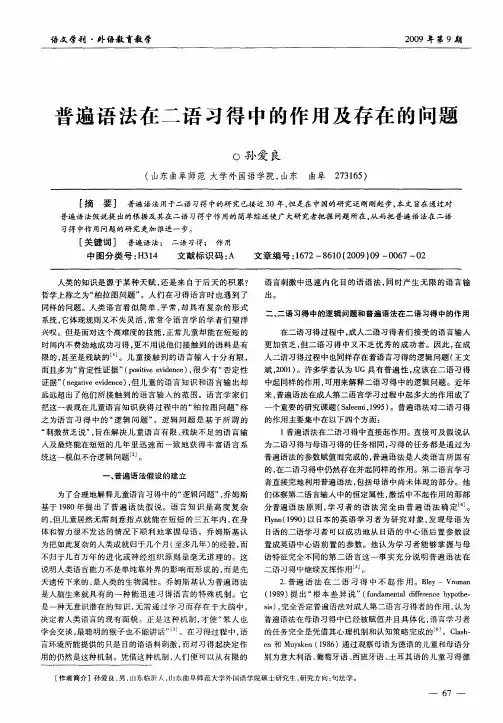
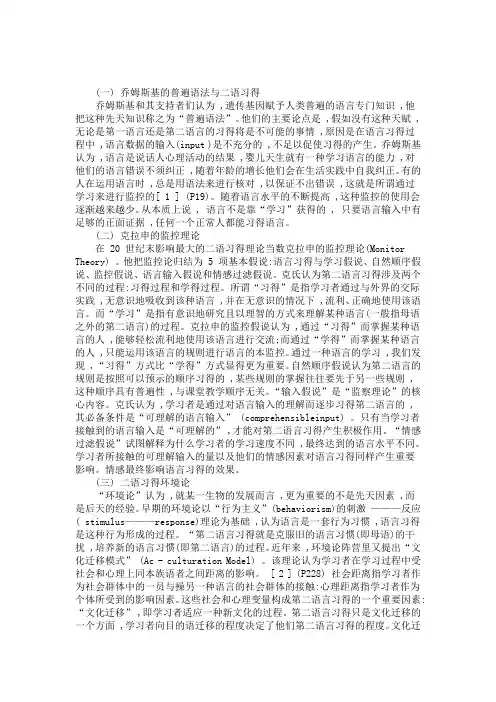
(一) 乔姆斯基的普遍语法与二语习得乔姆斯基和其支持者们认为 ,遗传基因赋予人类普遍的语言专门知识 ,他把这种先天知识称之为“普遍语法”。
他们的主要论点是 ,假如没有这种天赋 ,无论是第一语言还是第二语言的习得将是不可能的事情 ,原因是在语言习得过程中 ,语言数据的输入(input )是不充分的 ,不足以促使习得的产生。
乔姆斯基认为 ,语言是说话人心理活动的结果 ,婴儿天生就有一种学习语言的能力 ,对他们的语言错误不须纠正 ,随着年龄的增长他们会在生活实践中自我纠正。
有的人在运用语言时 ,总是用语法来进行核对 ,以保证不出错误 ,这就是所谓通过学习来进行监控的[ 1 ] (P19)。
随着语言水平的不断提高 ,这种监控的使用会逐渐越来越少。
从本质上说 , 语言不是靠“学习”获得的 , 只要语言输入中有足够的正面证据 ,任何一个正常人都能习得语言。
(二) 克拉申的监控理论在 20 世纪末影响最大的二语习得理论当数克拉申的监控理论(Monitor Theory) 。
他把监控论归结为 5 项基本假说:语言习得与学习假说、自然顺序假说、监控假说、语言输入假说和情感过滤假说。
克氏认为第二语言习得涉及两个不同的过程:习得过程和学得过程。
所谓“习得”是指学习者通过与外界的交际实践 ,无意识地吸收到该种语言 ,并在无意识的情况下 ,流利、正确地使用该语言。
而“学习”是指有意识地研究且以理智的方式来理解某种语言(一般指母语之外的第二语言)的过程。
克拉申的监控假说认为 ,通过“习得”而掌握某种语言的人 ,能够轻松流利地使用该语言进行交流;而通过“学得”而掌握某种语言的人 ,只能运用该语言的规则进行语言的本监控。
通过一种语言的学习 ,我们发现,“习得”方式比“学得”方式显得更为重要。
自然顺序假说认为第二语言的规则是按照可以预示的顺序习得的 ,某些规则的掌握往往要先于另一些规则 ,这种顺序具有普遍性 ,与课堂教学顺序无关。
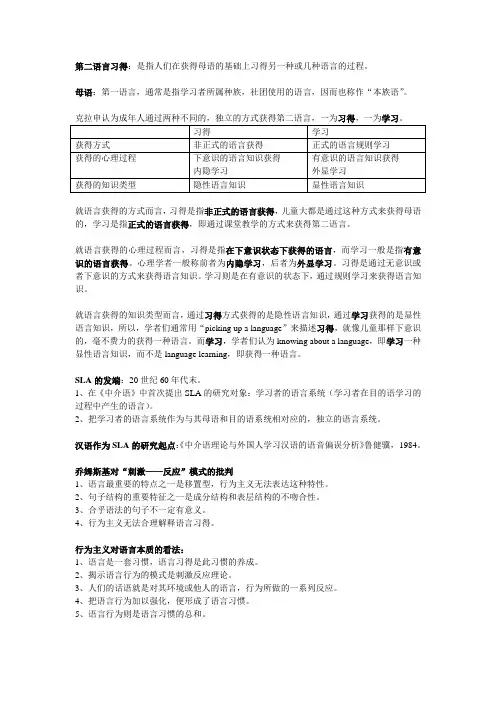
第二语言习得:是指人们在获得母语的基础上习得另一种或几种语言的过程。
母语:第一语言,通常是指学习者所属种族,社团使用的语言,因而也称作“本族语”。
就语言获得的方式而言,习得是指非正式的语言获得,儿童大都是通过这种方式来获得母语的,学习是指正式的语言获得,即通过课堂教学的方式来获得第二语言。
就语言获得的心理过程而言,习得是指在下意识状态下获得的语言,而学习一般是指有意识的语言获得。
心理学者一般称前者为内隐学习,后者为外显学习。
习得是通过无意识或者下意识的方式来获得语言知识。
学习则是在有意识的状态下,通过规则学习来获得语言知识。
就语言获得的知识类型而言,通过习得方式获得的是隐性语言知识,通过学习获得的是显性语言知识,所以,学者们通常用“picking up a language”来描述习得,就像儿童那样下意识的,毫不费力的获得一种语言。
而学习,学者们认为knowing about a language,即学习一种显性语言知识,而不是language learning,即获得一种语言。
SLA的发端:20世纪60年代末。
1、在《中介语》中首次提出SLA的研究对象:学习者的语言系统(学习者在目的语学习的过程中产生的语言)。
2、把学习者的语言系统作为与其母语和目的语系统相对应的,独立的语言系统。
汉语作为SLA的研究起点:《中介语理论与外国人学习汉语的语音偏误分析》鲁健骥,1984。
乔姆斯基对“刺激——反应”模式的批判1、语言最重要的特点之一是移置型,行为主义无法表达这种特性。
2、句子结构的重要特征之一是成分结构和表层结构的不吻合性。
3、合乎语法的句子不一定有意义。
4、行为主义无法合理解释语言习得。
行为主义对语言本质的看法:1、语言是一套习惯,语言习得是此习惯的养成。
2、揭示语言行为的模式是刺激反应理论。
3、人们的话语就是对其环境或他人的语言,行为所做的一系列反应。
4、把语言行为加以强化,便形成了语言习惯。
5、语言行为则是语言习惯的总和。
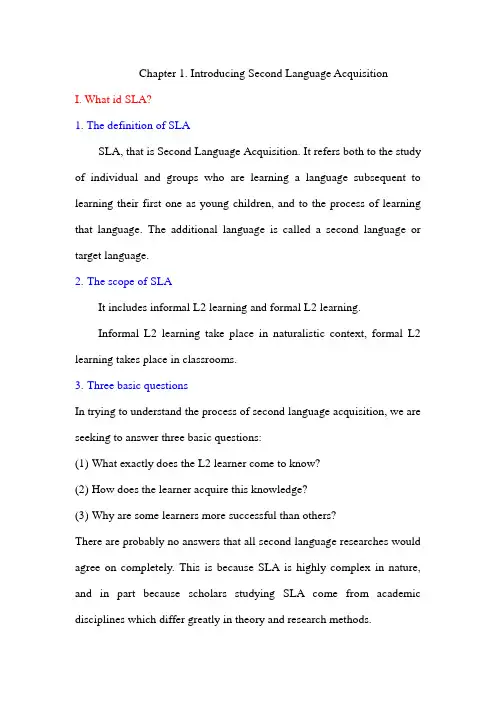
Chapter 1. Introducing Second Language AcquisitionI. What id SLA?1. The definition of SLASLA, that is Second Language Acquisition. It refers both to the study of individual and groups who are learning a language subsequent to learning their first one as young children, and to the process of learning that language. The additional language is called a second language or target language.2.The scope of SLAIt includes informal L2 learning and formal L2 learning.Informal L2 learning take place in naturalistic context, formal L2 learning takes place in classrooms.3.Three basic questionsIn trying to understand the process of second language acquisition, we are seeking to answer three basic questions:(1)What exactly does the L2 learner come to know?(2)How does the learner acquire this knowledge?(3)Why are some learners more successful than others?There are probably no answers that all second language researches would agree on completely. This is because SLA is highly complex in nature, and in part because scholars studying SLA come from academic disciplines which differ greatly in theory and research methods.II. What is a second Language?A second language is typically an official or societally dominant language needed for education, employment, and other basic purposes.A foreign language is one not widely used in the learners' immediate social context which might be used for further travel or other cross-cultural communication situations, or studied as a curricular requirement or elective in school, but with no immediate or necessary practical application.A library language is one which functions primarily as a tool for further learning through reading, especially when books or journals in a desired field of study are not commonly published in the learners' native tongue.An auxiliary language is one which learners need to know for some official functions in their immediate political setting, or will need for purposes of wider communication, although their first language serves most other needs in their lives.III. What is a first language?Acquisition of more than one language during early childhood is called simultaneous multilingualism.Sequential multilingualism: learning additional languages after L1.IV. Diversity in learning and learnersWhat is learned in acquiring a second language, as well as how it islearned is often influenced by whether the situation involves informal exposure to speakers of other languages, immersion in a setting where one needs a new language to meet basic needs, or formal instruction in school, and these learning conditions are often profoundly influenced by powerful social, cultural, and economic factors affecting the status of both languages and learners.Chapter 2 Foundations of Second Language AcquisitionI. The world of second languageNot only is bilingualism worldwide, it is a phenomenon that has existed since the beginning of language in human history. It is probably true that no language group has ever existed in isolation from other language groups. There are many more bilingual or multilingual individuals in the world than there are monolingual.Multilingualism refers to the ability to use two or more languages.Monolingualism refers to the ability to use only one.Those who grow up in a multilingual environment acquire multilingual competence in the natural course of using two or more languages from childhood with the people around them, and tend to regard it as perfectly normal to do so. Adding second languages at an older age often takes considerable effort, however, and thus requires motivation. This motivation may arise from a variety of conditions, including the following:(1)invasion or conquest of one's country by speakers of another language;(2)A need or desire to contact speakers of other languages in economic or other specific domains;(3)Immigration to a country where use of a language other than one's another language;(4)Adoption of religious beliefs and practices which involve use of another language.(5)A need or desire to pursue educational experience s where access requires proficiency in another language;(6)A desire for occupational or social advancement which is furthered by knowledge of another language;(7)An interest in knowing more about peoples of other cultures and having access to their technologies or literatures.II. Reasons for uncertainty in reporting language data include some which have social and political significance, and some which merely reflect imprecise or ambiguous terminology, for example:1.Linguistic information is often not officially collected2.Answers to questions seeking linguistic information may not be reliable3.There is lack of agreement on definition of terms and on criteria for identificationIII. The nature of language learningBy the age of six months an infant has produced all of the vowel sounds and most of the consonant sounds of any language in the world.On average children have mastered most of the distinctive sounds of their first language before they are three years old, and an awareness of basic discourse patterns such as conversational turn-taking appear at aneven earlier age. Children control most of the basic L1 grammatical patterns before they are five or six, although complex grammatical patterns continue to develop through the school years.The understanding of how children accomplish the early mastery of L1has changed radically in the past fifty years or so. (1). It was suggested that first language acquisition is in larger part the result of children's natural desire to please their doting parents. (2). Others argued that children's language acquisition is purposive, that they develop language because of their urge to communicate their wants and needs to the people who take care of them. (3). The most widely held view by the middle of the twentieth century was that children learn language by imitation .IV. The role of natural abilityHumans are born with a natural ability or innate capacity to learn language. In viewing the natural ability to acquire language in terms of innate capacity, we are saying that part of language structure is genetically "given" to every human child. If a child had to consciously learn the set of abstract principles that indicate which sequences of words are possible sentences in their language as opposed to those that are not, only the smartest would learn to talk, and it would take them many more years than it actually does.V. The role of social experienceEven if the universal properties of language are preprogrammed inchildren, they must learn all of those features which distinguish their L1 from all other possible human languages. Appropriate social experience , including L1 input and interaction, is thus a necessary condition for acquisition.Sources of L1 input and interaction vary depending on cultural and social factors. Mother's talk is often assumed to be the most important source of early language input to children. The relative importance of input from other young children also varies in different cultures, as does the importance of social institutions such as nursery schools.When young children's social experience includes people around them using two or more languages, they have the same innate capacity to learn both or all of them.VI. L1 versus L2 learningThis brief comparison of L1 and L2 learning is divided into three phases. The first is the initial state, which many linguists ans psychologists believe includes the underlying knowledge about language structures and principles that is in learner's heads at the very start of L1or L2 acquisition. The second phase, the intermediate states, covers all stages of basic language development. The third phase is the final state, which is the outcome of L1and L2 learning.(1). Initial stateSome linguists and psychologists believe that the genetic predispositionwhich children have from birth to learn language remains with them throughout life, and that differences in the final outcomes of L1and L2 learning are attributable to other factors. Others believe that some aspects of the innate capacity which children have for L1 remain in force for acquisition of subsequent languages, but that some aspects of this natural ability are lost with advancing age.There is complete agreement , however, that since L2 acquisition follows L1 acquisition , a major component of the initial state for L2 learning must be prior knowledge of L1.(2).Intermediate statesThere is similarity in that the development of both L1and L2 is largely systematic, including predictable sequencing of many phenomena within each and some similarity of sequencing across languages, and in the fact that L1and L2 learners both play a creative role in their own language development and do not mimic what they have heard or been taught. ·processes·necessary conditions·facilitating conditions(3)final stateThe final state is the outcome of L1or L2 learning . The final state of L1development is native linguistic competence. While vocabulary learning and cultivation of specialized registers may continue intoadulthood,the basic phonological and grammatical systems of whatever languages children hear around them re essentially established by the age of about five or six years , along with vocabulary knowledge and interaction skills that are adequate for fulfilling communicative functions. VII. The logical problem of language learningThe "problem" as it has been formulated by linguists relates most importantly to syntactic phenomena. As noted in the preceding section, most linguists ans psychologist assume this achievement must be attributed to innate and spontaneous language-learning construct and/or process. The notion that innate linguistic knowledge must underline language acquisition. This view has been supported by arguments such as the following:1.Children's knowledge of language goes beyond what could be learned from the input they receiveThis is essentially the poverty -of- the- stimulus argument. According to this argument, children often hear incomplete or ungrammatical utterances along with grammatical input,and yet they are somehow able to filter the language they hear so that the ungrammatical input is not incorporated into their L1 system.2.Constrains and principles cannot be learnedConstrains ans principles cannot be learned in part because children acquire a first language at an age when such abstractions are beyond theircomprehension; Constrains ans principles are thus outside the realm of learning processes which are related to general intelligence.3.Universal patterns of development cannot be explained by language-specific inputThe extent of this similarity suggests that language universals are not only constructs derived from sophisticated theories and analyses by linguists, but also innate representations in every young child's mind. The logical problem of language learningFirst of all, children often say things that adults do not.Next, children use language in accordance with general universal rules of language even though they have not yet developed the cognitive ability necessary to understand these rules.Finally, patterns of children's language development are not directly determined by the input they receive.VIII. Frameworks for SLAFrameworks for study of SLATimeline linguistic psychological social195os and before structuralism behaviorism sociocultural theory 1960s TGG neurolinguistics information processing ethnography of communication variation theory1970s functionalism humanistic models acculturation theroy1980s principles and parameters model connectionism social psychology1990s minimalist program processabilityThis view is still influential in SLA approaches which are concerned with the role of input and interaction.1.linguisticThere have been two foci for the study fo SLA from a linguistic perspective since 1960:internal and external. The internal focus has been based primarily on the work of Noam Chomsky and his followers. It sets the goal of study as accounting for speakers' internalized, underlying knowledge of language rather than the description of surface forms as in earlier Structuralism. The external focus for the study of SLA has emphasized language use, including the functions of language which are realized in learners' production at different stages of development.2.PsychologicalThere have been three foci in the study of SLA from a psychological perspective: languages and the brain, learning processes and learner differences.Language and the brainThe location and representation of language in the brain has been of interest to biologists and psychologists since the nineteenth century. And the expanding field of Neurolinguistics was one of the first to influencecognitive perspectives on SLA when systematic study began in th e1960s.Learning processesThe focus on learning processes has been heavily influenced by computer-based Information Processing(IP) models of learning, which were established in cognitive psychology by the 1960s. Explanations of SLA phenomena based on this framework involve assumptions that L2 is a highly complex skill, and that learning L2 is not essentially unlike learning other highly complex skills.Learner differencesThe focus on learner differences in SLA has been most concerned with the question of why some learners are more successful than others. This framework calls for consideration of emotional involvement in learning, such as affective factors of attitude, motivation, and anxiety level.SocialThere are two foci for the study of SLA from this perspective:micro-social and macro-social.Micro-social focusThe concerns within the micro-social focus relate to language acquisition and use in immediate social contexts of production, interpretation and interaction.Macro-social focusThe concerns fo the macro-social focus relate language acquisition and use to broader ecological contexts, including cultural, political and educational settings.。

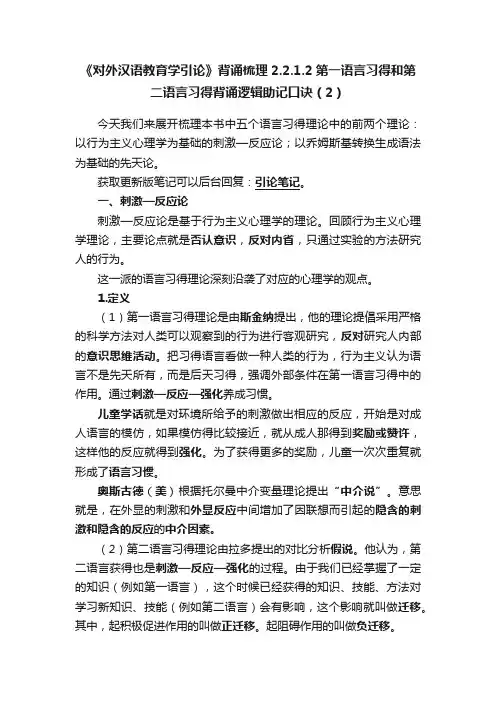
《对外汉语教育学引论》背诵梳理2.2.1.2第一语言习得和第二语言习得背诵逻辑助记口诀(2)今天我们来展开梳理本书中五个语言习得理论中的前两个理论:以行为主义心理学为基础的刺激—反应论;以乔姆斯基转换生成语法为基础的先天论。
获取更新版笔记可以后台回复:引论笔记。
一、刺激—反应论刺激—反应论是基于行为主义心理学的理论。
回顾行为主义心理学理论,主要论点就是否认意识,反对内省,只通过实验的方法研究人的行为。
这一派的语言习得理论深刻沿袭了对应的心理学的观点。
1.定义(1)第一语言习得理论是由斯金纳提出,他的理论提倡采用严格的科学方法对人类可以观察到的行为进行客观研究,反对研究人内部的意识思维活动。
把习得语言看做一种人类的行为,行为主义认为语言不是先天所有,而是后天习得,强调外部条件在第一语言习得中的作用。
通过刺激—反应—强化养成习惯。
儿童学话就是对环境所给予的刺激做出相应的反应,开始是对成人语言的模仿,如果模仿得比较接近,就从成人那得到奖励或赞许,这样他的反应就得到强化。
为了获得更多的奖励,儿童一次次重复就形成了语言习惯。
奥斯古德(美)根据托尔曼中介变量理论提出“中介说”。
意思就是,在外显的刺激和外显反应中间增加了因联想而引起的隐含的刺激和隐含的反应的中介因素。
(2)第二语言习得理论由拉多提出的对比分析假说。
他认为,第二语言获得也是刺激—反应—强化的过程。
由于我们已经掌握了一定的知识(例如第一语言),这个时候已经获得的知识、技能、方法对学习新知识、技能(例如第二语言)会有影响,这个影响就叫做迁移。
其中,起积极促进作用的叫做正迁移。
起阻碍作用的叫做负迁移。
根据语言谱系树理论,同一个语系甚至语族的两个语言,他们一定有很多结构、词汇相似之处。
第一语言和第二语言相似的语言成分容易学,不同成分则难学。
这一假说认为第二语言习得的主要障碍来自于第一语言(母语)的干扰。
需要通过对比两种语言的结构异同来预测第二语言习得的难点和易产生的错误,以便在教学中采用强化手段突出这些难点和重点,克服母语的干扰并建立习惯。
第一章:语言习得和语言教学第一课:第一语言和第二语言第一语言是个人身份的标志,总体水平也高于第二语言。
第二语言可以在不同环境中获得。
外语环境和二语环境,它们的区分主要取决于课堂之外的目的与是否常用。
第一、而与环境和外语环境的对立,取决与目的与在社区中是否常用。
第二、外语环境和二语环境的区分,有时并不像认为的那么简单。
第三、随着科学技术的进步,特别是因特网的普及,二语环境和外语环境的区别可能变得不那么重要。
第二课:语言习得语言习得即指语言习得这一现象,也指对这现象的研究。
第一语言习得研究的是儿童学习母语问题,也称“母语习得”。
第二语言习得包括对母语之外的所有语言的习得研究,研究对象一般是成年人。
语言习得研究中,有两个基本问题:逻辑问题和发展问题。
逻辑问题研究的课题是:语言习得是如何成为可能的?发展问题指的是:语言习得遵循一定的发展顺序和步骤。
第三课:应用语言学科德是应用语言学的早期代表人物之一。
语言教学和第二语言习得仍然是应用语言学的两个重要领域,但是应用语言学的研究范学科。
与应用语言学相对的,是理论语言学。
理论语言学的目的是对语言系统本身进行理论描述,找出其规律。
第四课:语言教学第一语言教学(母语教学)语言教学母语环境中的第二语言教学(或二语教学)第二语言教学对外环境的第二语言教学(外语教学)上图说明第二语言教学在两个层面上出现即广义:第二语言教学是从基本性质角度进行的分类,与第一语言教学相对。
狭义:第二语言教学是从学习环境角度进行的分类,和外语教学相对。
研究重点:学习机制、学习者语言、语言环境和语言习得、学习者个体差异。
第二语言教学研究的重点是教师和教学过程,第二语言习得研究的重点是学习和学习过程,包括中介语。
第五课:教学理念反应的是对语言学习和语言教学的基本认识。
包括:学习什么、怎样学习、如何教授。
理念是从一个人所受的全部语言教育当中,从这个人的语言学习有关的全部经历当中感悟出来的。
比较系统,有比较深厚的理论基础。
《第二语言学习知识习得研究》名词解释要点概括第二语言习得研究名词解释要点概括第一章第二语言习得研究概述第一节第二语言习得研究的基本概念1.母语:通常是指学习者所属种族、社团使用的语言,因而也称作“本族语”。
一般情况下,母语通常是儿童出生以后最先接触、习得的语言。
因此,母语通常也被称作“第一语言”。
2.目的语:也称“目标语”,一般是指学习者正在学习的语言。
它强调的是学习者正在学习的任何一种语言,与学习者的语言习得环境无关。
3.第一语言:指儿童幼年最先接触和习得的语言。
4.第二语言:相对于学习者习得的第一语言之外的任何一种其他语言而言的。
强调的是语言习得的先后顺序,与语言习得的环境无关。
5.习得:指“非正式”的语言获得。
“习得”通常是指在自然状态下“下意识”的语言获得。
内隐学习是通过无意识或下意识的方式来获得语言知识。
通过“习得”方式获得的是“隐性语言知识”。
6.学习:指“正式”的语言规则学习,即通过课堂教学的方式来获得第二语言。
一般是指“有意识”的语言知识的获得。
外显学习是在有意识的状态下通过规则学习来获得语言知识。
通过“学习”方式获得的是“显性语言知识”。
7.第二语言习得:指学习者在目的语国家学习目的语。
学习者所学的目的语在目的语国家是公认的交际工具,当然也是学习者用来交际的工具。
8.外语习得:学习者所学的语言在本国不是作为整个社团的交际工具,而且学习者所学的语言主要是在课堂学习的。
9.第二语言环境:指学习者所学的语言在语言习得发生的环境中作为交际语言。
10.自然的第二语言习得:指以交际的方式获得第二语言,而且语言习得通常是在自然的社会环境下发生的。
11.有指导的第二语言习得:以教学指导的方式获得第二语言,语言习得通常是在课堂教学环境中发生的。
12.语言能力:是由交际双方内在语法规则的心理表征构成的。
语言能力是一种反映交际双方语言知识的心理语法。
母语使用者对句子的合语法性的直觉判断依据的就是这种隐性语言知识。
第二语言习得研究笔记大家好呀!最近我一直在琢磨第二语言习得这事儿,感觉可有意思啦,就把自己的一些想法和发现都记下来啦,咱一起来看看呗。
一、啥是第二语言习得呀。
第二语言习得嘛,简单说就是除了咱们的母语之外,再去学习另外一门语言的过程。
比如说咱们中国人学英语、法语啥的,这就是在进行第二语言的习得啦。
为啥要学第二语言呢?嘿那好处可多啦。
能让咱们跟更多的人交流呀,了解不同国家的文化,要是以后出去旅游或者找工作,会一门外语那可就牛啦,机会都能多不少呢。
二、第二语言习得的过程。
这过程可不像咱们想象的那么简单哟。
一开始的时候,就跟刚学走路的小娃娃似的,啥都不懂。
得先从最基础的字母、发音学起,就像搭房子得先打地基一样。
比如说学英语,那26个字母得记熟吧,发音也得标准呀,不然人家都听不懂你在说啥。
等基础打得差不多了,就开始学一些简单的单词和句子啦。
这个时候就有点像在盖房子的第一层,得把材料一点点往上堆。
比如说“Hello”“How are you”这些简单的问候语,得多说多练,练到张嘴就来的那种程度。
再往后呀,就开始学语法啦。
语法这东西就像房子的框架,把单词和句子都给支撑起来。
不过语法可有点麻烦哟,各种时态、从句啥的,一不小心就晕头转向啦。
但没办法呀,还是得咬着牙学,多做练习题,多分析句子结构,慢慢就懂啦。
三、影响第二语言习得的因素。
这里面的因素可不少哟。
1. 学习动机。
这个可重要啦。
要是你真心喜欢这门语言,或者因为某种原因特别需要它,比如说你以后想当翻译,或者想去某个说这种语言的国家留学,那你学习的动力就会很足,学起来也就更带劲啦。
2. 学习环境。
环境对学习的影响也很大呢。
要是你身边都是说这种语言的人,比如说你在国外生活,那你天天听、天天说,进步肯定快呀。
就算没这个条件,咱也可以给自己创造环境呀,多看外语电影、听外语歌啥的。
3. 学习方法。
方法不对,努力白费哟。
有的人死记硬背,效果可能就不太好。
咱得找到适合自己的方法,比如说有的人喜欢通过对话来学习,那就多找机会和别人用外语聊天;有的人喜欢看剧学,那就多看一些有字幕的外语剧,一边看一边学。
第二语言习得研究概况-读书笔记第一篇:第二语言习得研究概况-读书笔记第二语言习得研究概况第一章介绍1.1 L2在世界中的地位:不仅在学校,而且影响人们生活的方方面面,在这个相互依存的世界里,SLA和二语使用无处不在。
1.2 为什么研究二语习得1.3 SLA领域的发展SLA研究的范围必须足够的广用来包含很多的受试,说很多不同的语言,在很多背景下因为很多原因习得很多L2。
第二章二语习得研究方法1.重要的不是选择定质方法范式还是定量方法范式,运用性质的最优结合来处理研究问题。
2.SLA研究者开始探寻SLA过程的理解,希望当语言教学与SLA 协调的时候语言教学会提高。
毫无疑问有好多相同点和不同点在教学中的习得和非教学中的习得。
然而我们不能忽视他们之间的相似性。
3.数据的收集尽可能真实自然,设计的好的工具能够使生产、直觉和情感数据的收集更加有效。
而且能够产色和那个更多完整和可比较的数据。
学习者在不同的任务中语言表现不同,因此应从多个角度来处理研究问题,并且研究者应避免做出不适当的概括。
4.语言水平很难定义,更别说测量。
第三章 SLA:数据分析的类型后一种分析的类型包含了前者,而不是代替前者。
除形位句法以外,语言的其他方面和交流能力也要能考虑到,对于语义方面,行为形成或规则形成都不可用,话语联想,多项区分和概念学习有更大的解释力。
第四章中介语研究:实证发现4.2.1 自由变量原因(1)IL在发展中变化地非常快(2)比起小孩习得母语来说,大一点的儿童和成人SL习得者很少认知上和心理语言学上受限制。
4.2.2 系统变量4.2.3 自由变量阻碍发展4.2.1对于变量的多种解释4.3 IL展现了共同的习得顺序和发展序列4.3.1习得顺序:形位研究4.3.2 发展序列:疑问句4.3.3 发展序列:否定句4.4 IL收学习者L1的影响相似点而不是不同点引起了主要的问题4.4.1 L1如何影响SLA(1)发展序列的步子被打断了(2)发展结构的数量改变了L1-L2的不同并没有改变发展序列,只是推迟了,推迟了开始,增加了次阶段。
中介语:L2学习者内化了心理语法,一个自然的语言系统可以用语言规则来描述。
目前的生成语言学关注中介语的表征,这一焦点可以视为原始的中介语假说的衍生。
中介语能力的本质,中介语语法多大程度上类似于其他语法以及UG的作用,都有一些明确的论述。
一直在争论的问题:UG是否对L2有调节作用,程度多大。
这个问题源于1.语言的普遍性的个别观点和2.关于语言能力本质的个别假说。
生成语法的传统观点,语法是心理表征,普遍规限制这些表征。
语言的普遍性的存在源于人类思想的属性,语法的存在源于他们的普遍规则。
UG在L2习得中的作用,前十年,主要关注“Access”:探索UG在非一语习得中是否仍然有效,这一问题关系到一些基本的问题:什么是自然的语言语法?语言能力的本质是什么,又是如何习得?UG的解释是一个局部的答案,至少在一语语法习得中是这样。
没有具体的天生的语言规则来限制语法,不可能习得语言?在L2习得研究中,问题是:中介语表征是否受UG的限制。
2. UG和语言习得的逻辑问题逻辑问题的由来:柏拉图本人认为,人类就是凭借天赋神授的理性,才得以获得广博无限的知识。
“柏拉图问题”同样表现在儿童语言能力的获得上。
对这一问题研究数十年的乔姆斯基,到最近还发出这样的惊叹: “儿童知道的远比经验提供的多……在语言生长的高峰时间,虽然儿童的语言接触非常有限,语言环境又模棱两可,但儿童大约每小时就可以学会一个词。
儿童理解词汇方式之精巧奇妙,非任何词典能及……语言习得更像是一般器官的生长;它是发生在儿童身上的事,并非儿童所做的事。
”(Chomsky , 2000 :6 - 7)语言学家们把这一表现在儿童语言知识获得过程中的“柏拉图问题”称之为语言习得中的“逻辑问题”。
简单地说, 逻辑问题基于所谓的“刺激贫乏说”,旨在解决儿童语言有限、残缺、不足的语料输入及最终能在短短几年里迅速而一致地获得丰富的语言系统这一貌似不合逻辑的问题。
无论是经验主义哲学的感觉经验,还是行为主义的刺激反应、重复模仿的“逻辑”都无法给予圆满的解释。
合乎逻辑的结论是儿童的语言习得过程是由天赋的语言知识UG的引导而完成的。
乔姆斯基把描写和解释儿童语言知识的初始状态作为语言科学研究的重要使命。
他认为,人的大脑具有模块性,是由许多既相互独立又以接口的方式相互连接的模块组成,如感知模块,认知模块等。
儿童语言知识也是一个独立、自足的模块,其特点无法从别的认知结构中推导或衍生,而是受人类语言的普遍原则的制约( Chomsky ,1986) 。
这些原则是构成人的内化语言能力的核心部分,是在人类进化过程中形成的生物遗传天赋的一部分,所以不需要后天学习,只需要在具体的语言环境中激活、生长。
儿童的语法学习任务仅限于在语言环境中为普遍语法参数赋值即可。
这就是为什么儿童可以很容易在短时间内学会母语的原因,也是乔姆斯基普遍语法理论对语言习得的“逻辑问题”的回答。
UG是与生俱来的语言能力。
UG包括不变的规则,也包括允许变化的参数。
乔姆斯基提出的三种理论(GB管辖约束理论, Minimalism最简方案, optimality最优理论)的共同点是:语言的某些属性都是抽象微妙的,且很复杂,如果没有天生的语言规则来限制语法,是很难习得语言的。
UG就能解释:为什么学习者知道远比输入要多的语法属性,他们如何了解某些是不可能的,为什么语法是这样而非那样的。
也就是说这些属性都不需要学习。
比如L1学习中,儿童接受到的句子和他们习得的抽象微妙复杂的知识之间就不匹配。
也就是说,起始输入不足以证明输出。
这一问题就是“刺激贫乏说”或者语言习得的逻辑问题。
一下就举例一个实验的例子,也就是OPC,证明这一规则,微妙而不可能从输入中习得。
3. UG和二语习得的逻辑问题人们就会存在疑问:L2习得是否和L1习得一样存在逻辑问题呢?首先在这里要区分两个东西:1. 逻辑问题(L2学习者是习得了超出输入的无意识知识,即心理表征)和2. UG的有效性(这种知识的获得是否是因为UG的有效性)通过反证法可以说,二语习得中,逻辑问题的存在是可能的。
有很多的研究,the access to UG 问题仍然存在:中介语表征是否证明UG规则限制的存在,中介语语法是否和本族语者一样瘦UG的限制。
举例说明Kanno的调查OPC,设计实验的假设是:UG限制每个人的语法,而小组结果解释个人的差异。
二语习得的环境和输入变量并不能完全决定学习者最后所获得的语言能力 ,二语习得中同样存在逻辑问题。
4.比较谬论在研究普遍语法是否在二语习得中可及的问题时 ,通行的做法是把学习者语言与目的语形式直接进行比较。
如果研究中的受试就某一参数或原则与说母语的本族语人士一致 , 就认为这一原则或参数是可及的 ,否则就是不可及的。
这样就形成了方法论上的“比较悖谬”,。
这种研究模式实际上是把学习者语言作为目的语的一种不完备变体 ,而没有将学习者语言本身作为一种独立的自然语言 ,所得出的结论也不能说明普遍语法是否对中间语起限制作用 ,只能说明中间语与目的语是否等同。
此外 , 普遍语法研究二语习得所倚重的主要方法为语法性判断和诱导模仿。
但这些方法的效度和信度都受到了的质疑。
语法性判断是形式语言学家使用的一种演绎性的研究方法 ,旨在反映本族语人士语言直觉和内化语言能力。
研究的对象是一个理想化、虚拟化的本族语人士(往往为语言学家本人) 。
但在第二语言习得研究里 ,这种方法要求受试就一组句子的语法性做出判断 ,这时 ,他们的语言能力系统是不完整的。
也就是说 ,我们根据他们对句子的实时处理 ,来推断出他们的语言能力水平 ,即根据语言行为来推知他们的语言能力。
这与 Chomsky等人所倡导的用语言“直觉”来推断语言能力的初衷相去甚远 ,因为我们要求学习者回答的往往超过他们目前的语言能力。
用这种方法得到的数据 , “与其说反映了学习者目前的知识系统 ,不如说更代表了他们的猜测” ,很容易产生“把受试的元语言行为直接归因于语言知识的危险”( Gass , 1994 :306) 。
这种语言能力和语言行为之间的错位也使得语法性判断的效度打了折扣。
Birdsong (1994) 发现 ,受试在做语法性判断题时 ,存在着一种系统性的“反应偏向” ,即更容易倾向于把句子判断为不合语法的 ,这种对称倾向也会影响研究的信度。
同时 ,对该方法信度的接研究结果也相互矛盾 ,无法让我们相信这是一种可信研究方法(如 Ellis ,1990 ;Gass ,1994) 。
Kanno的实验结果表明:源于UG的L2属性表现在中介语的语法中,中介语的语法和L2语法在这个方面集中于一点。
——。
1980年代许多研究者都清晰或含糊的解释到:如果中介语表征不能证明这些L2属性呢,如果中介语和L2互相偏离?这是否就意味着UG不存在呢?有些很清晰的论述: -比较二语学习者和本族语者对某一UG属性的判断是否一样?比如Schachter调查对于wh-移动的限制,认为UG的不存在。
但这一方法存在一个问题:就是它预设了中介语表征必须集中于L2本族语者的语法,即二语学习者必须到达和本族语者一样的最终于发,但这个错误的。
中介语语法是从L2语法的一个分支,、5.UG的access可及性和术语的混淆Direct Access:a.L2 learners arrive at UG properties independently of their L1 独立于L1b.instantiation of any legitimate parameter setting 任何合法参数设置的实例化Full Access:代替Direct Accessindirect/partial access针对UG和L1,过于简单的使用二分法,L1是自然语言,没有先验证明:基于L1的表征意味着UG不限制中介语语法。
需要关注的是:L2学习者达到的表征的本质,不一定停留在UG的Access问题上,可以更细节的观察中介语表征的本质。
6.中介语表征:收敛,发散,削弱预设:中介语语法和L2的本族语者语法在某些方面存在偏离,至少是起初或最终的。
那偏离的本质:预示着表征受UG的限制还是语言有一些削弱,有缺陷二语习得的“逻辑问题”预设学习者大脑的某种初始状态对外语学习的进程及最终获得的语言能力起着至关重要的作用。
起始状态理论也就是说:L2学习者开始表征,以及用于理解L2输入的表征。
6.1 例子:强特征和动词移动Functional categories, such asinflection (I), complementizer (C), and determiner (D), have certain formal features 动词的限定形式:充当谓语时受人称和数的限制,时态,语态,语气的限定动词的非限定形式:除了谓语的其他成分,不定式,动名词和分词等法语和英语的曲折特征强度比较(见书)6.2 起始状态关于起始中介语表征的观点主要分为两类A.中介语表征遵照自然语言的属性: Full transferB.中介语表征在基本方面不同于成人的自然语言:Minimal Tress 假设,无效的根据FTFA,中介语表征必定不同于L2的本族语者的语法,至少起始时是这样。
中介语表征在发展的最后阶段也不一定和L2语法集中于一点提升动词(raisingverbs)是一类能使句子补语分句中动词主语发生移位,即“NP提升” (Chomsky1981,1993)的动词。
如果我们将母语习得与二语习得做一比较 ,就会发现 ,二者的“初始状态”存在重大差异: 在母语习得中 ,儿童的认知能力和语言能力都不健全 ,但二语学习者的认知能力已趋于完备 ,并且已经掌握了或完全掌握了自己的母语;儿童的普遍语法的参数值处于待设定的缺省状态 ,而二语习得者的普遍语法已经在母语习得环境的作用下转化为具体语法。
如果我们可以说儿童母语习得的初始状态仅仅是普遍语法的话 ,那么 , 成人外语学习的初始状态至少包含三个部分:一是已经得到全面发展的认知能力;二是已经完全掌握了的母语;三是可能仍然起限制作用或已不再起作用的普遍语法。
这样 ,对二语习得的逻辑问题的回答 ,从本质上讲 ,其实就是对这三个要素在二语习得中所占的份额、它们之间的接口及其互动关系的研究。
其核心是普遍语法在二语习得中究竟扮演何种角色。
7. 表征之外普遍语法是一个关于语言知识表征的理论 ,本身并非语言习得理论。
它的主要功能是描写并解释人类语言系统的限制条件。
要对二语习得中的“逻辑问题”给出圆满解释 ,不仅需要回答“什么”的问题 ,还要回答“怎样”的问题;不仅要确认普遍语法对二语习得过程的限制作用 ,更重要的是对这些原则和参数在二语习得中的可学得性做出解释。